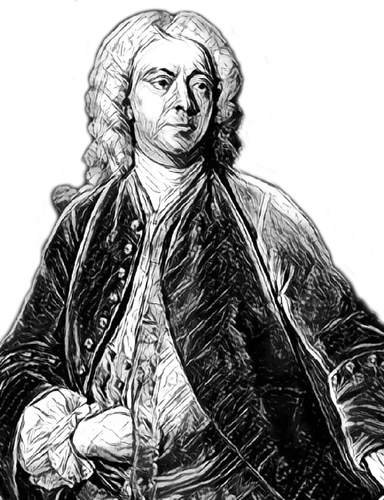 |
 |
|||
|
|
Stephen Poyntz, born
in London and baptised at St. Michael's, Cornhill in November 1685, was the
second son of William Poyntz, upholsterer, of Cornhill, by his second wife,
Jane, daughter of Stephen Monteage, merchant of London and Buckingham, whose
wife was a sister of the regicide, Admiral Richard Deane. He was educated at Eton, being a King's
Scholar and Captain of Montem in 1702. On 17th February 1703, he was
admitted to King's College, Cambridge and, in due course, became a fellow,
graduating as a BA in 1706 and MA five years later.
Shortly after he left college, Poyntz travelled with the Duke of
Devonshire, and he also became tutor to the sons of Lord Townshend, with
whom he was at the Hague in 1709 and 1710. For some time, he seems to have
acted as Townshend's confidential secretary, communicating on his behalf
with the English ambassadors abroad, and, through his employer's influence,
he was introduced into the Diplomatic Service. In 1716, Poyntz was
commissary to James, 1st Earl Stanhope, the Secretary of State, followed, in
1724, by the position of Envoy-Extraordinary and Plenipotentiary to Sweden.
Of this latter mission Poyntz acquitted himself well, though Sir Robert
Walpole complained of the large sums which he drew from the English
exchequer to secure Sweden's support. In 1728, Poyntz was sent as
commissioner to the congress at Soissons, where he made the acquaintance of
George, 1st Baron Lyttelton, and he remained in France until the Summer of
1730.
On the formation of the household of the Duke
of Cumberland, second son of King George II, in 1731, Poyntz was appointed as
the young Duke's governor and steward of the household, and, throughout his
life, he continued as the prince's trusted adviser. Although he had rooms in
St. James' Palace, about 1735, Poyntz
purchased, from the family of Hillersdon, an estate at Midgham,
a chapelry in the parish of Thatcham,
near Newbury in Berkshire. He
became well known in the area and was always easily recognised by the red
coat that he wore. The
Duke of Cumberland spent some of his early years there and two rooms, long called 'the
Duke's Rooms,' were added to the house for his accommodation. Ponytz became
good friends with Queen Caroline (of Anspach) and, as a mark of
esteem for his services, she placed a very beautiful vase,
ornamented with figures in high relief, in the grounds at Midgham House.
Poyntz played an important part at the Royal Court. In 1734, he acted as
the medium of communication between the King and Queen and an Austrian
envoy. It was in his rooms at St. James's Palace that, in 1735, the famous
Earl of Peterborough formally acknowledged to the company that Anastasia
Robinson was his wife. In the same year, Poyntz was created a privy
councillor and he received the sinecure post of inspector of prosecutions in
the exchequer concerning 'prohibited and uncustomed goods.' He died at
Midgham, on 17th December 1750, and was buried there. Horace Walpole says
that he was "ruined in his circumstances by a devout brother, whom he
had trusted, and by a simple wife, who had a devotion of marrying dozens of
her poor cousins at his expense; you know she was the 'Fair Circassian.' Mr.
Poyntz was called a very great man, but few knew anything of his talents,
for he was timorous to childishness. The Duke has done greatly for his
family and secured his places for his children, and sends his two sons
abroad, allowing them £800 a year". Poyntz's influence at court, his
talents, and his kindly disposition were acknowledged on all sides. Carlyle,
in his 'Memoirs of Frederick the Great,' characteristically describes him as
"once bright gentleman, now dim and obsolete."
Poyntz married, in February 1733, Anna Maria Mordaunt, daughter of the
Hon. Brigadier-General Lewis Mordaunt and maid of honour to Queen Caroline.
She had been a great beanty and her charms were described by Samuel Croxall
in his poem of the 'Fair Circassian.' They had two sons - William of Midgham
(d. 1809) and Charles, a prebendary at Durham Cathedral - and two daughters,
Margaret Georgina and Louisa. The latter died unmarried, but Margaret
Georgina became the wife, at Althorp on 27th December 1755, of John,
afterwards 1st Earl Spencer. Mrs. Calderwood of Polton met the Spencers and
the whole of the Poyntz family travelling through Spa in great state in
1756. Mrs. Poyntz was then a "deaf, short-sighted, loud-spoken,
hackney-headed wife, and played at cards from morning till night." Mrs.
Spencer was "a very sweet-like girl; her sister is a great
hoyden." Mrs. Poyntz was in great favour at Versailles in August 1763,
when she cured Madame Victoire of the stone. She died at Midgham, on 14th
November 1771, and was buried in the parish
church in Thatcham.
Poyntz was the author of a 'Vindication of the Barrier Treaty,' which has
been erroneously printed among Bishop Hare's writings. It was an 'excellent
work'. Lord Lyttelton, Lord Hervey, Sir C. Hanbury Williams, Nicholas
Hardinge, and others addressed verses to Poyntz. He was also a friend of
Samuel Richardson, the novelist. Through his agency, the sum of £100 is
said to have been granted, by Queen Caroline, to Elizabeth Elstob, and when
James Ferguson, the astronomer, came to London, in May 1743, be brought with
him a letter of recommendation to Poyntz, who befriended him in every way.
Ferguson drew the portraits of Mrs. Poyntz and the children, so that Poyntz
might be able from personal knowledge to speak favourably of the skill of
the artist. Edited from Leslie Stephens & Sidney Lee's "Dictionary of National Biography" (1891).
|
|||
| © Nash Ford Publishing 2003. All Rights Reserved. | ||||



 Stephen Poyntz (1685-1750)
Stephen Poyntz (1685-1750)